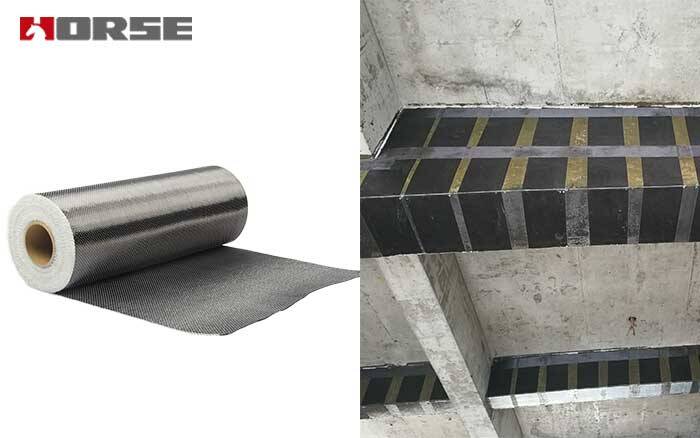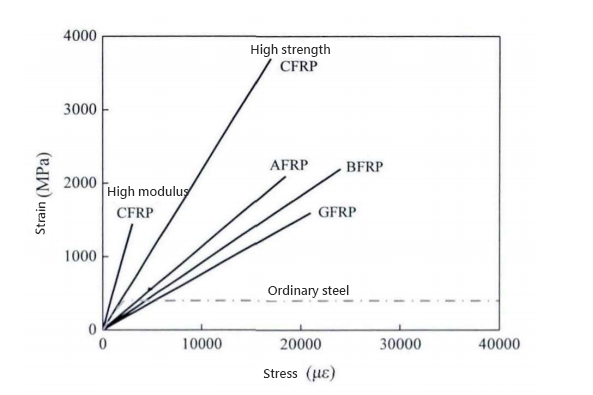Solutions
Horse Construction offers full range of structural strengthening materials with technical supports, documentation supports, products supports, project supports.
Features of FRP External Bonded Reinforced Steel Structure Technology

Fiber-reinforced composite material (Fiber Reinformed Polymer, referred to as FRP) refers to a new type of composite material that uses continuous fiber as a reinforcement and polymer resin as a matrix, mixed in a certain proportion and made by a certain composite process. For FRP, continuous fiber is the main body of the force, and the role of the matrix is to connect the fiber tows and coordinate the force. Therefore, the properties of the fiber and the matrix jointly determine the macro-mechanical properties of FRP.
According to the type of continuous fiber in FRP, FRP commonly used in civil engineering can be divided into carbon fiber reinforced composite material (CFRP), glass fiber reinforced composite material (GFRP), basalt fiber reinforced composite material (BFRP) and aramid fiber reinforced composite material (AFRP) and so on. For different types of FRP materials, due to different fiber types, their ultimate strength and elastic modulus are quite different, but the most notable feature is the linear elastic properties of the material itself. The mechanical properties of common FRP materials are shown in the figure

The most commonly used structural reinforcement material in civil engineering is steel. Compared with steel, FRP materials have significantly different mechanical properties, as shown in the figure. Therefore, understanding and mastering the characteristics of FRP materials is conducive to making better use of the advantages of FRP in civil engineering applications. Compared with traditional materials, FRP materials have the following advantages:
(1) Lightweight and high-strength
FRP materials have light weight and high tensile strength. The tensile strength of carbon fiber, which is most commonly used in civil engineering, can reach 10 times that of ordinary steel, and its weight is only about 1/4 of that of steel. The lightweight and high-strength characteristics of FRP make it possible to reduce the weight and super-span of the engineering structure. For example, the use of FRP materials instead of steel, FRP grid lightweight seismic walls, FRP lightweight bridge decks, etc. can effectively reduce the structural weight and realize the lightweight of super high-rise buildings and long-span bridges. The use of FRP cables can further increase the span of long-span bridges. In addition, the lightweight characteristics of FRP components make them easy to transport and install, and their application in new structures is conducive to industrial production; their application in reinforcement and restoration is conducive to rapid post-disaster restoration in areas with inconvenient transportation.
(2) Good durability
FRP materials have good corrosion resistance. The degradation rate of most FRPs in harsh environments is much lower than that of steel, and can be used for a long time in acid, alkali, salt and humid environments. In the wave splash zone on the Pacific coast of California, USA, GFRP, which is used to repair severely corroded and damaged concrete structures, has been in service for more than 10 years, and the performance indicators of GFRP and the integrity of the structure have not changed significantly. Reinforced concrete structures generally will have cracks caused by steel reinforcement corrosion in 5-15 years. If they are not repaired in time and adequate anti-corrosion measures are taken, the structure will quickly reach the limit of damage.
(3) Excellent fatigue resistance
FRP materials have excellent fatigue resistance. Studies have shown that BFRP can be cyclically loaded two million times at about 60% of the maximum stress without fracture. Under the same stress ratio, the fatigue resistance of CFRP is significantly better than that of structural steel. The fatigue test of the FRP-reinforced reinforced concrete structure shows that the failure of the specimen starts from the fatigue fracture of the steel bar.
(4) Strong designability
The designability of FRP is mainly reflected in two aspects. On the one hand, the performance of composite materials can be designed by changing the direction and sequence of the FRP layers, so as to maximize the repair effect. On the other hand, there are many types of FRP, and different FRPs have obvious differences in elastic modulus, strength, elongation, etc. Through the mixing of different FRPs and the combination of FRP and steel, the comprehensive mechanical properties of FRP can be improved, and structural materials that meet the requirements of different engineering structures and high comprehensive performance can be realized.

Features of FRP Externally Reinforced Steel Structure
The FRP externally attached reinforcement steel structure technology is to paste the FRP sheet to the surface of the damaged part of the steel structure by coating a special adhesive on the surface of the damaged area of the steel structure. A reinforcement method to make the steel structure and FRP pasted into a whole, coordinate deformation and work together. Compared with the traditional steel structure reinforcement method, the FRP external paste reinforcement steel structure technology has obvious advantages, which can be roughly summarized into the following three aspects
(1) Advantages in material performance
Compared with the steel plate in the traditional reinforcement method, the FRP material has higher specific strength and specific rigidity, and the amount of FRP required to achieve the same strength is less and lighter. Therefore, the weight and size of the original structure are basically not increased after reinforcement. FRP has good corrosion resistance to acid, alkali, salt and other corrosive media. Although the price of FRP material itself is higher than that of steel, FRP reinforcement can reduce maintenance costs in the later period, thereby reducing the life cycle cost of the structure. The FRP material has good fatigue resistance and can avoid the adverse effect of the traditional reinforcement method of the steel plate itself on the reinforcement effect. FRP is highly designable, and the repair effect can be maximized by changing the composition of FRP and the direction and order of FRP layering according to the degree of damage and stress of the structure.
(2) Advantages in force performance
Compared with the method of welding and bolting steel plates, FRP external paste reinforcement does not add new welds, does not generate residual stress, and does not require drilling of the base metal. Therefore, there is basically no damage to the original structure, and no new fatigue sensitive source will be formed. Compared with the method of pasting the steel plate, due to the small thickness of the FRP, the stress concentration of the bonding interface is lower. In addition, the externally attached FRP belongs to the inter-plane connection, and the entire bonding surface can bear the load, which overcomes the defects of the welding method only relying on the welding seam and the screw connection method only relying on the bolt to transmit the force, so that the force transmission after reinforcement is more uniform and effective
(3) Advantages in construction
The FRP external paste reinforcement method is convenient and efficient in construction. Through the FRP external paste reinforcement, the economic losses caused by traffic interruption and production shutdown can be significantly reduced. In addition, FRP external paste reinforcement does not require open flames, and is suitable for the reinforcement of special environments and components such as oil refineries and oil pipelines.
You can find anything here you are in need of, have a trust trying on these products, you will find the big difference after that.

High strength, unidirectional carbon fiber wrap pre-saturated to form a carbon fiber reinforced polymer (CFRP) wrap used to strengthen structural concrete elements.

High strength carbon fiber reinforced polymer (CFRP) strip / laminate / plate for structural strengthening and concrete repair

Prestressed carbon fiber reinforced polymer(CFRP) plate for slab, beam strengthening to increase stiffness, reduce distortion and deflection of members, reduce the cracks, avoid and stop cracking.